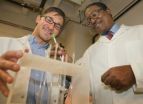(Press-News.org) A group of agricultural scientists reported in today's issue of the journal Science that corn that has been genetically engineered to produce insect-killing proteins isolated from the soil bacterium Bacillus thuringiensis (Bt) provides significant economic benefits even to neighboring farmers who grow non-transgenic varieties of corn.
"Modern agricultural science is playing a critical role in addressing many of the toughest issues facing American agriculture today, including pest management and productivity," said Agriculture Secretary Tom Vilsack. "This study provides important information about the benefits of biotechnology by directly examining how area-wide suppression of corn borers using Bt corn can improve yield and grain quality even of non-Bt varieties."
The researchers estimate that farmers in Iowa, Illinois, Minnesota, Nebraska and Wisconsin received cumulative economic benefits of nearly $7 billion between 1996-2009, with benefits of more than $4 billion for non-Bt corn farmers alone. The scientists estimated that in Minnesota, Illinois and Wisconsin, borer populations in adjacent non-Bt fields declined by 28 to 73 percent, with similar reductions recorded in Iowa and Nebraska.
The researchers attribute the collateral benefits enjoyed by non-Bt farmers to areawide suppression of corn borers stemming from long-term plantings of Bt-protected crops. Potato, green bean and other host crops also stand to benefit from areawide reductions of corn borers, the researchers note. The team's Science report also highlights the importance of the use of refuge crops—the planting of non-Bt crops adjacent to fields of Bt crops, providing a refuge to which the pests can retreat—and other strategies to slow the corn borer's ability to develop resistance to Bt and thus maintain the insecticidal proteins' long-term effectiveness.
The Bt proteins provide the plant with a built-in defense against attacks by the larvae of European corn borers and other insect pests. Larvae that ingest the protein soon stop feeding and die, typically within 48 hours. In addition to reducing the use of insecticides that also can endanger beneficial insects, the Bt defense strategy helps prevent harmful molds from gaining entry to the plants via wound sites from borer feeding. Some of these molds, like Fusarium, produce mycotoxins that can diminish the value and safety of the crop's kernels.
Bt corn debuted in 1996, and by 2009 was planted on nearly 55 million acres in the United States, accounting for nearly 63 percent of the total U.S. corn crop of 87 million acres. But no research groups had previously investigated the long-term impact of such plantings on corn borer populations on a regional scale, nor had there been any assessment of whether the use of the crop provided any sort of collateral benefit to adjacent or nearby fields of non-Bt crops.
The team was led by William Hutchison of the University of Minnesota and included Rick Hellmich, a U.S. Department of Agriculture (USDA) entomologist at the Corn Insects and Crop Genetics Research Unit operated at Ames, Iowa, by the Agricultural Research Service (ARS). ARS is USDA's principal intramural scientific research agency. The team gathered 14 years' worth of corn borer population data from Bt corn plantings and combined it with national corn production figures, including yields, prices and acreage planted.
INFORMATION:
In addition to ARS and the University of Minnesota, study participants included researchers from the University of Wisconsin at Madison, Pennsylvania State University at State College, the University of Illinois at Urbana, the University of Nebraska at Lincoln, Iowa State University at Nashua, and industry researchers, among others.
USDA is an equal opportunity provider, employer and lender. To file a complaint of discrimination, write: USDA, Director, Office of Civil Rights, 1400 Independence Ave., S.W., Washington, D.C. 20250-9410 or call (800) 795-3272 (voice), or (202) 720-6382 (TDD).
New study shows benefits of Bt corn to farmers
2010-10-08
ELSE PRESS RELEASES FROM THIS DATE:
Stem cells shape up to their surroundings
2010-10-08
London, UK (October, 07, 2010) –Many scientists aspire to take control over the stem cell differentiation process, so that we can grow organs and implants perfectly matched to each patient in the future. Now research in the Journal of Tissue Engineering, published by SAGE-Hindawi, explains how engineering the topography on which stem cells grow, and the mechanical forces working on them, can be as powerful an agent for change as their chemical environment.
Stem cells respond to the stiffness, chemistry and topography of the environments they find themselves in – and scientists ...
Election forecasts favor Republican gains in midterm
2010-10-08
WASHINGTON, DC-In the weeks leading up to the 2010 midterm elections, five forecasters or teams of forecasters offer models and predictions for the House in the most recent issue (October 2010) of PS: Political Science and Politics, a journal of the American Political Science Association. The models offer a broad consensus that the Republicans will make substantial gains in the House, although there is not a consensus over how large those gains will be. A 30-seat spread between the low and high end of the seat change forecast range exists, with two forecasters giving an ...
Structure of plastic solar cells impedes their efficiency
2010-10-08
A team of researchers from North Carolina State University and the U.K. has found that the low rate of energy conversion in all-polymer solar-cell technology is caused by the structure of the solar cells themselves. They hope that their findings will lead to the creation of more efficient solar cells.
Polymeric solar cells are made of thin layers of interpenetrating structures from two different conducting plastics and are increasingly popular because they are both potentially cheaper to make than those currently in use and can be "painted" or printed onto a variety ...
Stanford-led study disproves link between genetic variant, risk of coronary artery disease
2010-10-08
STANFORD, Calif. — A genetic marker touted as a predictor of coronary artery disease is no such thing, according to a study led by researchers at the Stanford University School of Medicine.
The massive international study, published online Oct. 7 in the Journal of the American College of Cardiology, assessed the predictive value of a leading genetic assay for risk of atherosclerosis.
The study analyzed the data from more than 17,000 patients with cardiovascular disease and 40,000 others to assess whether carrying a particular variant of the KIF6 gene indicated a greater ...
New tool in the fight against tuberculosis
2010-10-08
Researchers at the Institute for Genomic Biology at the University of Illinois have developed a way to harness the prodigious quantities of both genomic and metabolic data being generated with high-throughput genomics and other techniques. They have developed an algorithm that automatically integrates both data sets. The model, called probabilistic regulation of metabolism (PROM), enables researchers to perturb a given regulatory gene or metabolic process and see how that affects the entire network.
"PROM provides a platform for studying the behavior of networks in a ...
Thoughts about time inspire people to socialize
2010-10-08
Does thinking about time or money make you happier? A new study published in Psychological Science, a journal of the Association for Psychological Science, finds that people who are made to think about time plan to spend more of their time with the people in their lives while people who think about money fill their schedules with work, work, and—you guessed it—more work.
To find out how thinking about time or money makes people feel, Cassie Mogilner of the University of Pennsylvania designed an experiment, carried out online with adults from all over the United States, ...
Brown University chemists simplify biodiesel conversion
2010-10-08
PROVIDENCE, R.I. [Brown University] — As the United States seeks to lessen its reliance on foreign oil, biodiesel is expected to play a role. According to the National Renewable Energy Laboratory, a branch of the Department of Energy, biodiesel "represents a significant energy resource and could someday supply 3 percent to 5 percent of the distillate fuel market."
One major obstacle to achieving that goal is figuring how to efficiently convert the abundant stocks of waste vegetable oil (oil used after cooking French fries, for example) into biodiesel fuel. Current techniques ...
Melanoma uses body's immune system to spread to lungs
2010-10-08
The way melanoma cells use the immune system to spread and develop into lung tumors may lead to a therapy to decrease development of these tumors, according to Penn State researchers.
"Melanoma is the most aggressive and metastatic form of skin cancer," said Gavin Robertson, professor of pharmacology, pathology, dermatology and surgery in the Penn State College of Medicine. "Therefore, identifying proteins and molecular mechanisms that regulate metastasis is important for developing drugs to treat this disease."
Metastasis is a complex process in which cancer cells ...
MIT researchers develop a better way to see molecules at work in living brain cells
2010-10-08
CAMBRIDGE, Mass. -- By creating a better way to see molecules at work in living brain cells, researchers affiliated with MIT's Picower Institute for Learning and Memory and the MIT Department of Chemistry are helping elucidate molecular mechanisms of synapse formation. These studies could also help further understanding of how synapses go awry in developmental diseases such as autism and Fragile X syndrome. The study will appear in the Oct. 7 issue of Cell.
Using the new technique, which is more accurate and sensitive than existing methods, the researchers found that ...
US invested $139 billion in health research in 2009
2010-10-08
WASHINGTON—October 7, 2010—The U.S. invested $139 billion last year in health research from all public and private sources, according to Research!America's latest annual estimate. That amount represents only 5.6% of the $2.47 trillion overall U.S. health spending in 2009—or 5.6¢ of every health dollar—which varies no more than 0.2% from 2005 levels.
The estimate is available here: http://www.researchamerica.org/uploads/healthdollar09.pdf.
The 2009 investment grew by only 0.1% over 2008. This small increase can be attributed largely to the federal stimulus funding ...

